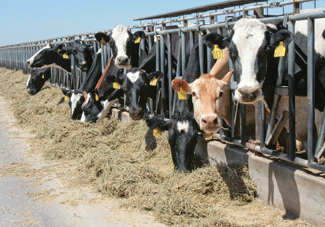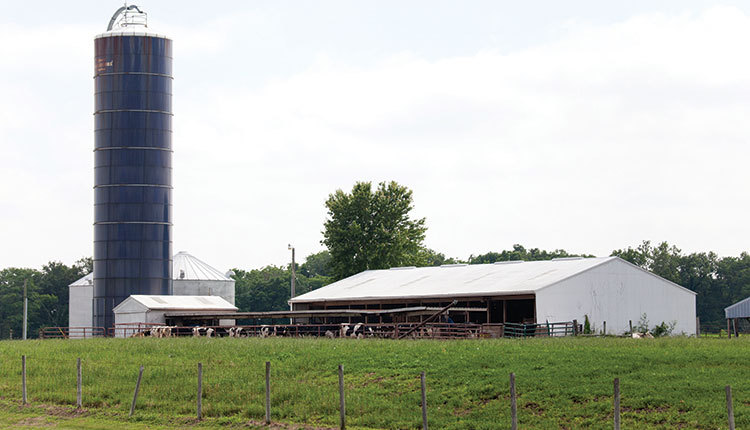The author is a dairy nutrition consultant for Central Connecticut Cooperative Farmers in Hartford, Conn. He previously managed large dairies in California and Hawaii.

No matter if milk prices are high or low, more often than not it's to your advantage to maximize milk production - and milk components - per cow. But, with the nonstop volatility in both the milk market and feed market, it's certainly a challenge for each of you to decide if you should continue feeding for high levels of milk components.
It's well known, of course, that the more total pounds of fat and protein in your milk, the greater its value. And getting the most out of increased milk components is not just about boosting the percentage of each in the milk but at the same time to also improve milk yield. To do this, we must feed our cows well-formulated diets that maximize the rumen microbial growth as well as the amino acids absorbed in the small intestine.
Milkfat synthesis in the mammary gland has been well understood for many years, with the main emphasis on adequate effective fiber in the rumen. Manipulating milk protein through diet has not been as easy to accomplish . . . and because of that milk protein percentage and yield has remained below the radar for many years.
Since 2000, when component pricing was adopted in much of the country, the price paid for both milkfat and milk protein has been on a roller coaster ride. Trying to keep track of those individual prices has been next to impossible. For many of us, equating milk component values to the better understood price-per-hundredweight usually takes a computer spreadsheet or a calculator.

The chart shows the average component prices for the Federal Milk Marketing Orders since 2000. Even though there has been significant volatility from year to year, the contribution to the milk check for fat and protein has been about the same for much of that time.
In 2007, however, a weakened U.S. dollar suddenly caused our dairy products to become a "good deal" on the world market, and the value of protein shot up. This added several dollars per hundred to milk checks nationwide. Then in late 2008, with the developing worldwide financial crisis, protein values returned to more normal numbers.
Costs are changing . . .
Predictions for milk prices in 2009 are well below those in 2008 which certainly is not that unusual from one year to the next . . . we're used to that. What's going to make things much more difficult to handle this time around are the unprecedented high feed prices that began in 2008, most likely continuing through 2009. Along with the higher prices of energy and energy-related items such as fertilizer, even $18 milk may not pay the bills for many dairy farms in 2009.
But, believe it or not, there's an easy dollar per hundredweight to be had on your milk check if you work at boosting milk components a couple of points.
Say you're a dairy farmer with a herd of Holstein cows averaging 70 pounds of milk most of the year. Your butterfat usually runs 3.5 percent, and your protein is 3.0 percent. With a milk price for March of 2009 at $14.50 per hundredweight which was predicted when this was written, you could improve that by a whole $1 if you could get your components up to 3.8 percent and 3.2 percent.
Of course, the highest of milk prices won't make you any money if you don't keep production costs in line, and feed costs will continue to be a struggle for most dairy farms.
The key to getting high milk production along with high components is feeding a diet that's accurately balanced for fermentable carbohydrates along with protein sources that feed the rumen microbes. To get there requires high-quality feedstuffs, aggressive reproduction management, and paying close attention to details such as feeding and milking schedules, as well as cow comfort.
You must focus on your forages, first of all. Getting high butterfat tests is directly tied to highly digestible forages, effective fiber, and a properly buffered rumen environment. With corn silage, high grain content, and a good fermentation profile are imperative. For grass and legume forages the protein content is usually the key . . . the higher the better.
The primary driver of high milk yield in a cow is blood glucose. This is the "energy" aspect of the diet. And, as we all know, energy tends to be the limiting nutrient in a cow's diet . . . the most difficult requirement to meet. Fermentable carbohydrates, which come primarily from the grains and by-product commodities, are fermented into fatty acids that ultimately convert to glucose in the liver. You can't get good sources of energy from overly mature, highly lignified forages; nor does it come from moldy or spoiled feeds.
Next, you need to look at protein and amino acid balance. The primary focus of protein nutrition is the rumen degradable protein (RDP) which is the nitrogen source for the rumen microbes. The protein a cow needs for her systemic metabolic needs comes from the spent rumen microbes absorbed in the small intestine, along with additional rumen undegradable protein (RUP) supplied through the diet.
Both milk yield and milk protein levels depend on both the percentages and levels of essential amino acids contained in the protein that's absorbed through the small intestine. These metabolizable amino acids have their greatest positive impact on milk production when they are at levels similar to that of the cow's tissue. The research has shown that the most limiting amino acids are lysine and methionine.
Research conducted by Charles Schwab of the University of New Hampshire has determined that the optimum levels of metabolizable lysine and methionine for a high-producing cow are 185 grams and 62 grams per day. Current ration balancing software such as NRC (National Research Council), CPM (Cornell-Penn-Miner), and CNCPS all calculate these values in a diet very easily, and all programs are very accurate.
What can we afford?
The question we need to ask ourselves with today's feed prices and low milk prices is "will it pay to incorporate those changes in a diet that will make more milk and raise milk components?" Schwab's work from several years back showed that the cost of rebalancing a milk cow feed ration with proper carbohydrate and amino acid levels is nominal and may even cost less, depending on where the crude protein level was to begin with. Many diets that are formulated for high milk production often will have higher than necessary crude protein levels that do not properly address amino acid levels. In some cases, the redesign of a ration will result in more milk revenue with little or no rise in feed cost - but results do vary.
Work with your feed company professional or nutritionist to:
• Balance carbohydrates.
• Evaluate starch and fiber digestibility.
• Provide adequate effective fiber.
• Balance for RDP and RUP.
• Provide lysine and methionine supplementation to meet metabolizable requirements for those amino acids.
• Develop a strategy that will keep cows comfortable, giving them plenty of time to eat and rest every day.
• Pay close attention to financial details such as debt and cash flow.
Dairy farms are complex organizations where many variables have to be managed in a timely manner to allow the business to run smoothly and efficiently. It becomes even more crucial during unsure economic times to pay attention to those small details such as a couple of points of milk components.
Click here to return to the Nutrition E-Sources
090510_325

No matter if milk prices are high or low, more often than not it's to your advantage to maximize milk production - and milk components - per cow. But, with the nonstop volatility in both the milk market and feed market, it's certainly a challenge for each of you to decide if you should continue feeding for high levels of milk components.
It's well known, of course, that the more total pounds of fat and protein in your milk, the greater its value. And getting the most out of increased milk components is not just about boosting the percentage of each in the milk but at the same time to also improve milk yield. To do this, we must feed our cows well-formulated diets that maximize the rumen microbial growth as well as the amino acids absorbed in the small intestine.
Milkfat synthesis in the mammary gland has been well understood for many years, with the main emphasis on adequate effective fiber in the rumen. Manipulating milk protein through diet has not been as easy to accomplish . . . and because of that milk protein percentage and yield has remained below the radar for many years.
Since 2000, when component pricing was adopted in much of the country, the price paid for both milkfat and milk protein has been on a roller coaster ride. Trying to keep track of those individual prices has been next to impossible. For many of us, equating milk component values to the better understood price-per-hundredweight usually takes a computer spreadsheet or a calculator.

The chart shows the average component prices for the Federal Milk Marketing Orders since 2000. Even though there has been significant volatility from year to year, the contribution to the milk check for fat and protein has been about the same for much of that time.
In 2007, however, a weakened U.S. dollar suddenly caused our dairy products to become a "good deal" on the world market, and the value of protein shot up. This added several dollars per hundred to milk checks nationwide. Then in late 2008, with the developing worldwide financial crisis, protein values returned to more normal numbers.
Costs are changing . . .
Predictions for milk prices in 2009 are well below those in 2008 which certainly is not that unusual from one year to the next . . . we're used to that. What's going to make things much more difficult to handle this time around are the unprecedented high feed prices that began in 2008, most likely continuing through 2009. Along with the higher prices of energy and energy-related items such as fertilizer, even $18 milk may not pay the bills for many dairy farms in 2009.
But, believe it or not, there's an easy dollar per hundredweight to be had on your milk check if you work at boosting milk components a couple of points.
Say you're a dairy farmer with a herd of Holstein cows averaging 70 pounds of milk most of the year. Your butterfat usually runs 3.5 percent, and your protein is 3.0 percent. With a milk price for March of 2009 at $14.50 per hundredweight which was predicted when this was written, you could improve that by a whole $1 if you could get your components up to 3.8 percent and 3.2 percent.
Of course, the highest of milk prices won't make you any money if you don't keep production costs in line, and feed costs will continue to be a struggle for most dairy farms.
The key to getting high milk production along with high components is feeding a diet that's accurately balanced for fermentable carbohydrates along with protein sources that feed the rumen microbes. To get there requires high-quality feedstuffs, aggressive reproduction management, and paying close attention to details such as feeding and milking schedules, as well as cow comfort.
You must focus on your forages, first of all. Getting high butterfat tests is directly tied to highly digestible forages, effective fiber, and a properly buffered rumen environment. With corn silage, high grain content, and a good fermentation profile are imperative. For grass and legume forages the protein content is usually the key . . . the higher the better.
The primary driver of high milk yield in a cow is blood glucose. This is the "energy" aspect of the diet. And, as we all know, energy tends to be the limiting nutrient in a cow's diet . . . the most difficult requirement to meet. Fermentable carbohydrates, which come primarily from the grains and by-product commodities, are fermented into fatty acids that ultimately convert to glucose in the liver. You can't get good sources of energy from overly mature, highly lignified forages; nor does it come from moldy or spoiled feeds.
Next, you need to look at protein and amino acid balance. The primary focus of protein nutrition is the rumen degradable protein (RDP) which is the nitrogen source for the rumen microbes. The protein a cow needs for her systemic metabolic needs comes from the spent rumen microbes absorbed in the small intestine, along with additional rumen undegradable protein (RUP) supplied through the diet.
Both milk yield and milk protein levels depend on both the percentages and levels of essential amino acids contained in the protein that's absorbed through the small intestine. These metabolizable amino acids have their greatest positive impact on milk production when they are at levels similar to that of the cow's tissue. The research has shown that the most limiting amino acids are lysine and methionine.
Research conducted by Charles Schwab of the University of New Hampshire has determined that the optimum levels of metabolizable lysine and methionine for a high-producing cow are 185 grams and 62 grams per day. Current ration balancing software such as NRC (National Research Council), CPM (Cornell-Penn-Miner), and CNCPS all calculate these values in a diet very easily, and all programs are very accurate.
What can we afford?
The question we need to ask ourselves with today's feed prices and low milk prices is "will it pay to incorporate those changes in a diet that will make more milk and raise milk components?" Schwab's work from several years back showed that the cost of rebalancing a milk cow feed ration with proper carbohydrate and amino acid levels is nominal and may even cost less, depending on where the crude protein level was to begin with. Many diets that are formulated for high milk production often will have higher than necessary crude protein levels that do not properly address amino acid levels. In some cases, the redesign of a ration will result in more milk revenue with little or no rise in feed cost - but results do vary.
Work with your feed company professional or nutritionist to:
• Balance carbohydrates.
• Evaluate starch and fiber digestibility.
• Provide adequate effective fiber.
• Balance for RDP and RUP.
• Provide lysine and methionine supplementation to meet metabolizable requirements for those amino acids.
• Develop a strategy that will keep cows comfortable, giving them plenty of time to eat and rest every day.
• Pay close attention to financial details such as debt and cash flow.
Dairy farms are complex organizations where many variables have to be managed in a timely manner to allow the business to run smoothly and efficiently. It becomes even more crucial during unsure economic times to pay attention to those small details such as a couple of points of milk components.
090510_325










